Ring Wrinkle Patterns with Continuously Changing Wavelength Produced Using a Controlled-Gradient Light Field
Abstract
1. Introduction
2. Experimental Section
2.1. Materials
2.2. Film Fabrication
2.3. Characterization
3. Results and Discussion
3.1. Fabrication of Gradient 1-D Wrinkle Patterns and Sample Characterization
3.2. Variable-Period Ring Wrinkles Fabrication and Characterization
4. Conclusions
Author Contributions
Funding
Acknowledgments
Conflicts of Interest
References
- Efimenko, K.; Rackaitis, M.; Manias, E.; Vaziri, A.; Mahadevan, L.; Genzer, J. Nested self-similar wrinkling patterns in skins. Nat. Mater. 2005, 4, 293–297. [Google Scholar] [CrossRef] [PubMed]
- Genzer, J.; Groenewold, J. Soft matter with hard skin: From skin wrinkles to templating and material characterization. Soft Matter 2006, 2, 310–323. [Google Scholar] [CrossRef]
- Li, B.; Cao, Y.P.; Feng, X.Q.; Gao, H. Mechanics of morphological instabilities and surface wrinkling in soft materials: A review. Soft Matter 2012, 8, 5728–5745. [Google Scholar] [CrossRef]
- Miao, L.; Cheng, X.; Chen, H.; Song, Y.; Guo, H.; Zhang, J.; Chen, X.; Zhang, H. Fabrication of controlled hierarchical wrinkle structures on polydimethylsiloxane via one-step C4F8 plasma treatment. J. Micromech. Microeng. 2018, 28, 015007. [Google Scholar] [CrossRef]
- Park, S.K.; Kwark, Y.J.; Nam, S.; Moon, J.; Dong, W.K.; Park, S.; Park, B.; Yun, S.; Lee, J.I.; Yu, B. A variation in wrinkle structures of UV-cured films with chemical structures of prepolymers. Mater. Lett. 2017, 199, 105–109. [Google Scholar] [CrossRef]
- Pretzl, M.; Schweikart, A.; Hanske, C.; Chiche, A.; Zettl, U.; Horn, A.; Böker, A.; Fery, A. A lithography-free pathway for chemical microstructuring of macromolecules from aqueous solution based on wrinkling. Langmuir 2008, 24, 12748–12753. [Google Scholar] [CrossRef] [PubMed]
- Yang, S.; Khare, K.; Lin, P.C. Harnessing surface wrinkle patterns in soft matter. Adv. Funct. Mater. 2010, 20, 2550–2564. [Google Scholar] [CrossRef]
- Bowden, N.; Brittain, S.; Evans, A.G.; Hutchinson, J.W.; Whitesides, G.M. Spontaneous formation of ordered structures in thin films of metals supported on an elastomeric polymer. Nature 1998, 393, 146–149. [Google Scholar]
- Bowden, N.; Huck, W.T.S.; Paul, K.E.; Whitesides, G.M. The controlled formation of ordered, sinusoidal structures by plasma oxidation of an elastomeric polymer. Appl. Phys. Lett. 1999, 75, 2557–2559. [Google Scholar] [CrossRef]
- Efimenko, K.; Wallace, W.E.; Genzer, J. Surface modification of Sylgard-184 poly(dimethyl siloxane) networks by ultraviolet and ultraviolet/ozone treatment. J. Colloid Interface Sci. 2002, 254, 306–315. [Google Scholar] [CrossRef] [PubMed]
- Chakraborty, A.; Xiang, M.; Luo, C. Fabrication of super-hydrophobic microchannels via strain-recovery deformations of polystyrene and oxygen reactive ion etch. Materials 2013, 6, 3610–3623. [Google Scholar] [CrossRef] [PubMed]
- Chan, E.P.; Crosby, A.J. Fabricating microlens arrays by surface wrinkling. Adv. Mater. 2010, 18, 3238–3242. [Google Scholar] [CrossRef]
- Chan, E.P.; Smith, E.J.; Hayward, R.C.; Crosby, A.J. Surface wrinkles for smart adhesion. Adv. Mater. 2010, 20, 711–716. [Google Scholar] [CrossRef]
- Khare, K.; Zhou, J.; Yang, S. Tunable open-channel microfluidics on soft poly(dimethylsiloxane) (PDMS) substrates with sinusoidal grooves. Langmuir 2009, 25, 12794–12799. [Google Scholar] [CrossRef] [PubMed]
- Chung, J.Y.; Youngblood, J.P.; Stafford, C.M. Anisotropic wetting on tunable micro-wrinkled surfaces. Soft Matter 2007, 3, 1163–1169. [Google Scholar] [CrossRef]
- Zhao, J.; Guo, X.; Lu, L. Controlled wrinkling analysis of thin films on gradient substrates. Appl. Math. Mech. -Engl. Ed. 2017, 38, 1–8. [Google Scholar] [CrossRef]
- Li, K.; Wang, J.; Shao, B.; Xiao, J.; Zhou, H.; Yu, S. Wrinkling patterns of tantalum films on modulus-gradient compliant substrates. Thin Solid Films 2018, 654, 100–106. [Google Scholar] [CrossRef]
- Yu, S.; Sun, Y.; Ni, Y.; Zhang, X.; Zhou, H. Controlled formation of surface patterns in metal films deposited on elasticity-gradient PDMS substrates. ACS Appl. Mater. Interfaces 2016, 8, 5706–5714. [Google Scholar] [CrossRef] [PubMed]
- Kai, U.C.; Tebbe, M.; Giesa, R.; Schweikart, A.; Fery, A.; Schmidt, H.W. Towards tailored topography: Facile preparation of surface-wrinkled gradient poly(dimethyl siloxane) with continuously changing wavelength. RSC Adv. 2012, 2, 10185–10188. [Google Scholar]
- Filiatrault, H.L.; Carmichael, R.S.; Boutette, R.A.; Carmichael, T.B. A self-assembled, low-cost, microstructured layer for extremely stretchable gold films. ACS Appl. Mater. Interfaces 2015, 37, 20745–20752. [Google Scholar] [CrossRef] [PubMed]
- Lee, J.S.; Hong, H.; Park, S.J.; Lee, S.J.; Dong, S.K. A simple fabrication process for stepwise gradient wrinkle pattern with spatially-controlled wavelength based on sequential oxygen plasma treatment. Microelectron. Eng. 2017, 176, 101–105. [Google Scholar] [CrossRef]
- Dow Consumer Solutions. Available online: https://consumer.dow.com/en-us/pdp.sylgard™ 184 silicone elastomer kit.01064291z.html (accessed on 21 January 2018).
- Ouyang, M.; Muisener, R.J.; Boulares, A.; Koberstein, J.T. UV–ozone induced growth of a SiOx surface layer on a cross-linked polysiloxane film: Characterization and gas separation properties. J. Membr. Sci. Technol. 2000, 177, 177–187. [Google Scholar] [CrossRef]
- Jiang, H.; Khang, D.Y.; Song, J.; Sun, Y.; Huang, Y.; Rogers, J.A. Finite deformation mechanics in buckled thin films on compliant supports. Proc. Natl. Acad. Sci. USA 2007, 104, 15607–15612. [Google Scholar] [CrossRef] [PubMed]
- Bayley, F.A.; Liao, J.L.; Stavrinou, P.N.; Chiche, A.; Cabral, J.T. Wavefront kinetics of plasma oxidation of polydimethylsiloxane: Limits for sub-μm wrinkling. Soft Matter 2014, 10, 1155–1166. [Google Scholar] [CrossRef] [PubMed]
- Li, R.; Yi, H.; Hu, X.; Chen, L.; Shi, G.; Wang, W.; Yang, T. Generation of diffraction-free optical beams using wrinkled membranes. Sci. Rep. 2013, 3, 2775. [Google Scholar] [CrossRef] [PubMed]
- Saito, A.C.; Matsui, T.S.; Sato, M.; Deguchi, S. Aligning cells in arbitrary directions on a membrane sheet using locally formed microwrinkles. Biotechnol. Lett. 2014, 36, 391–396. [Google Scholar] [CrossRef] [PubMed]
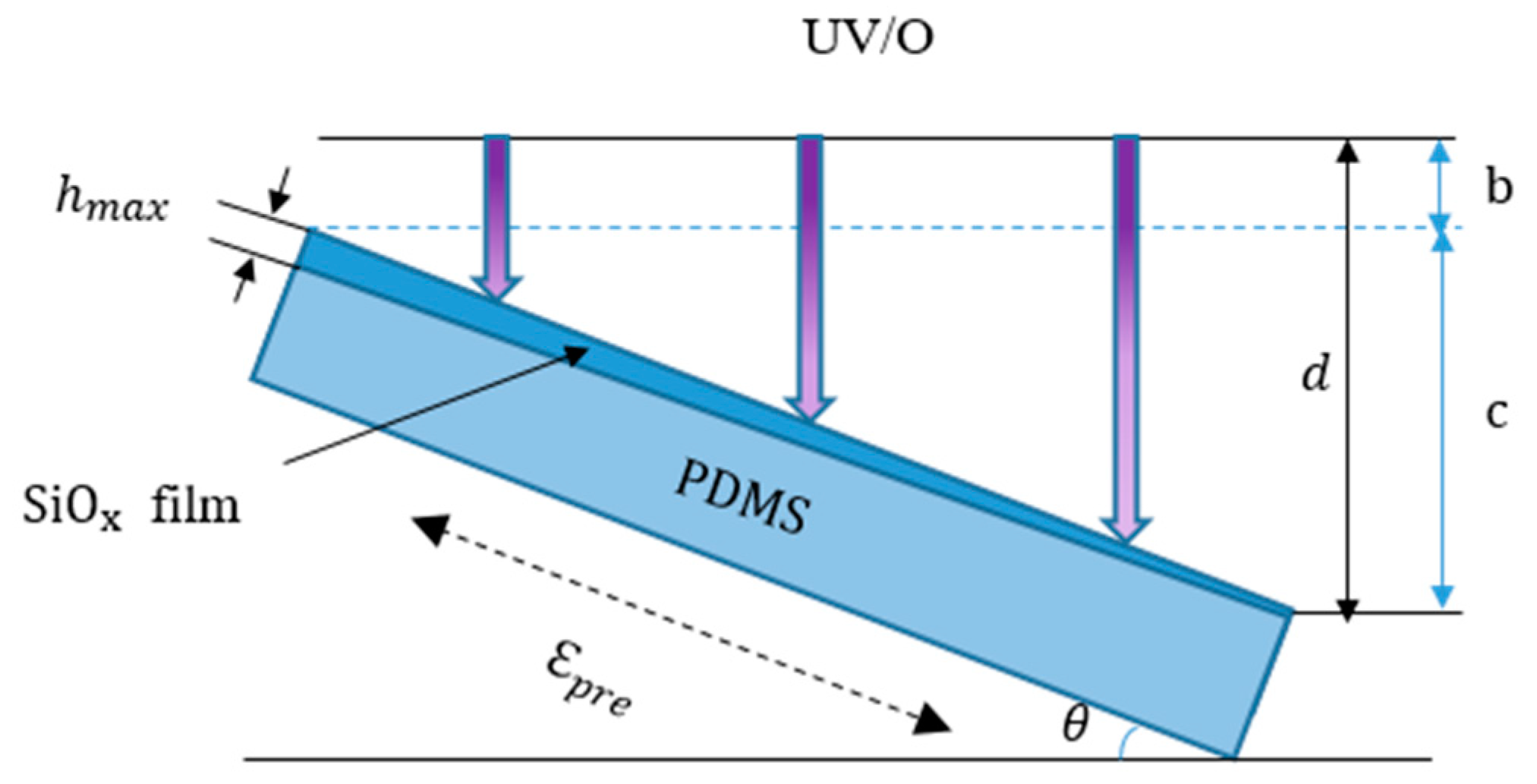

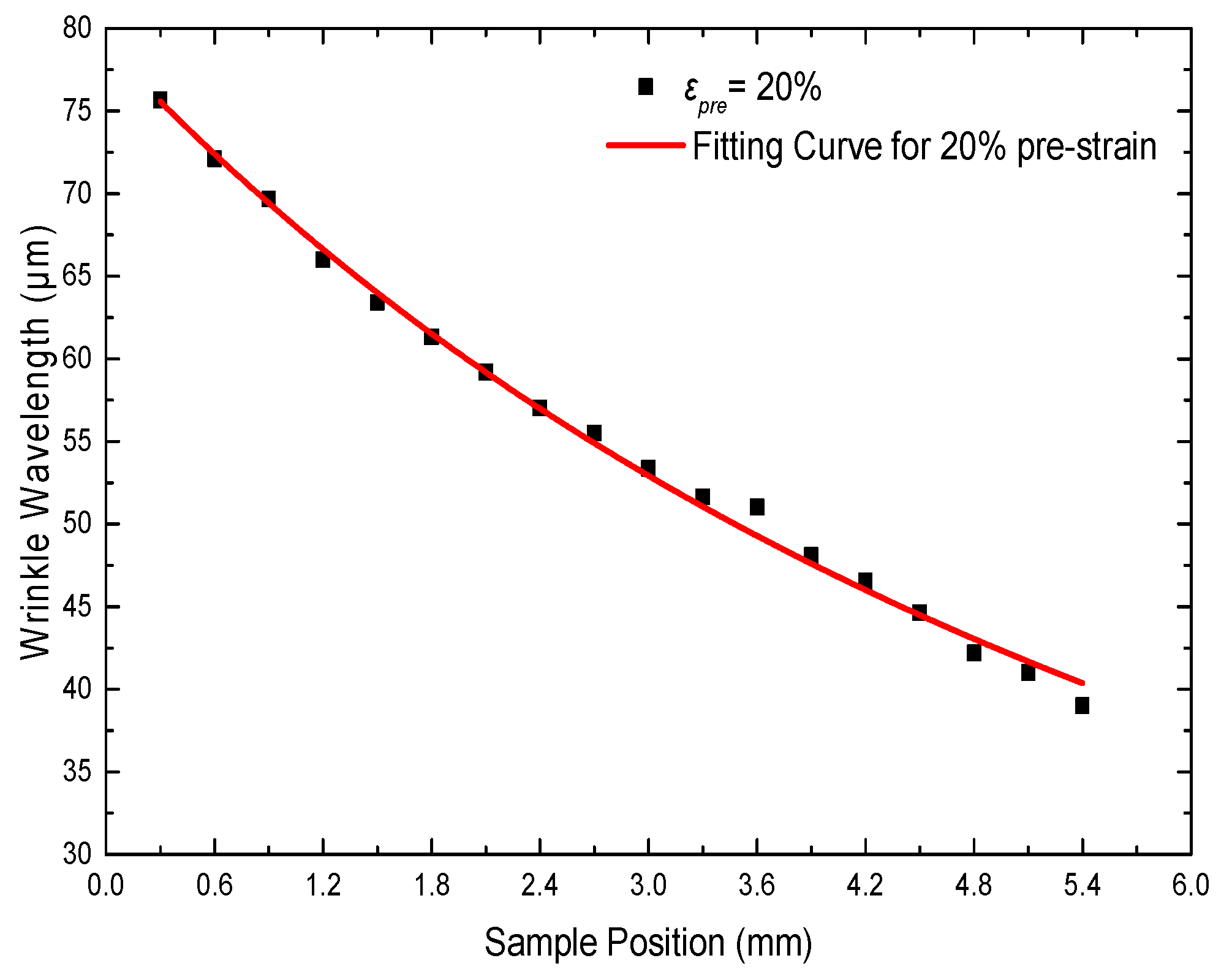

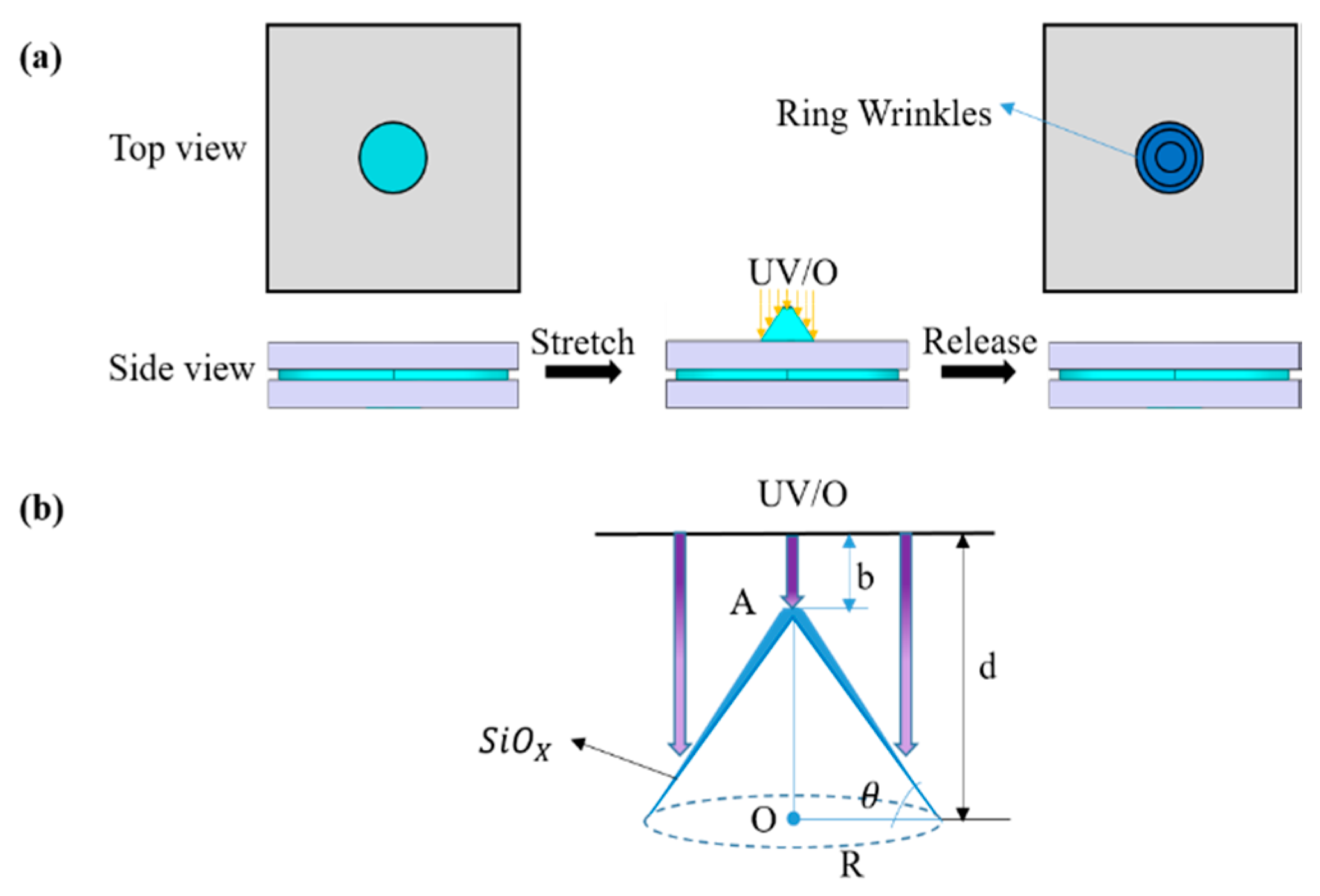
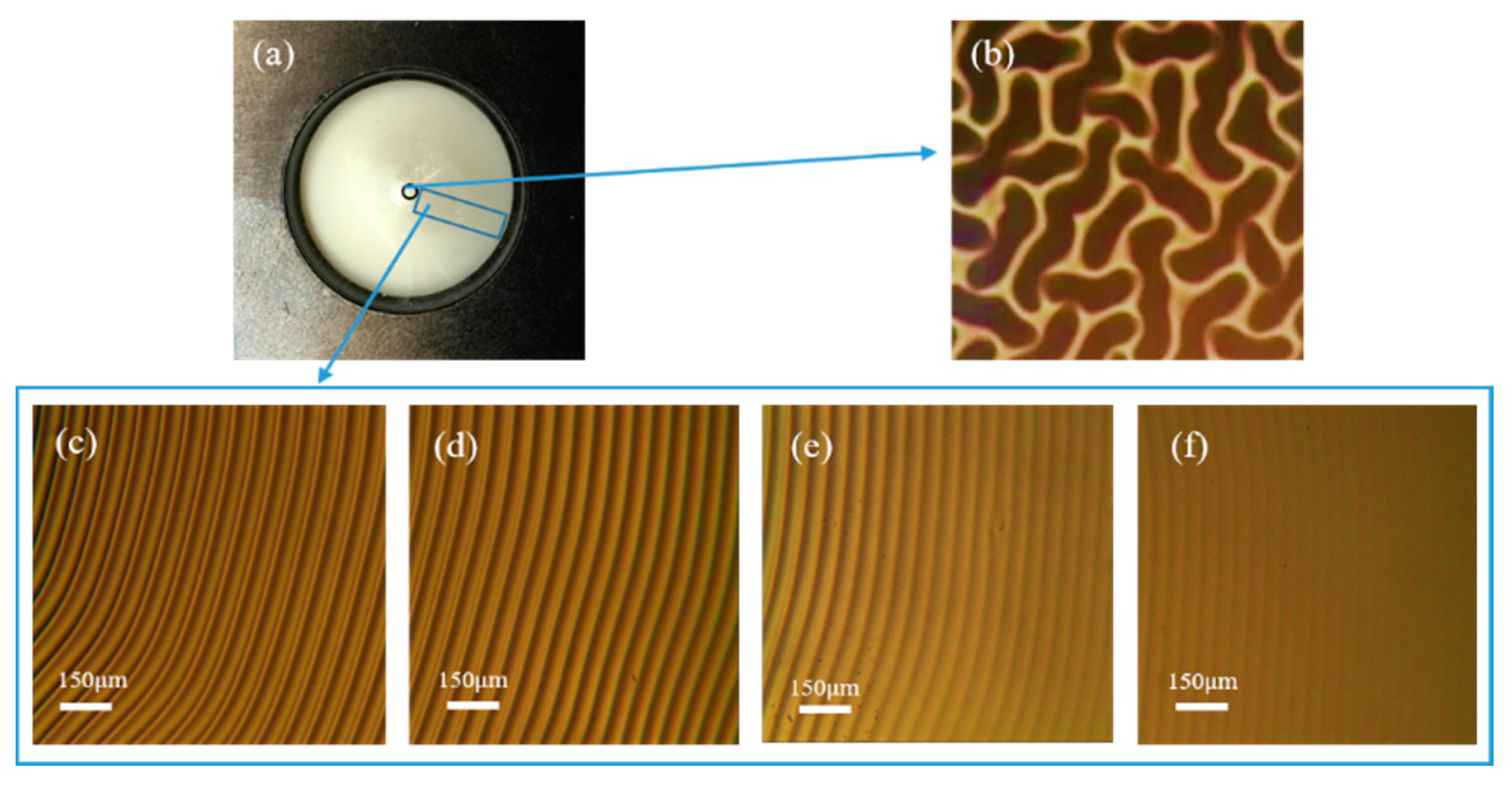
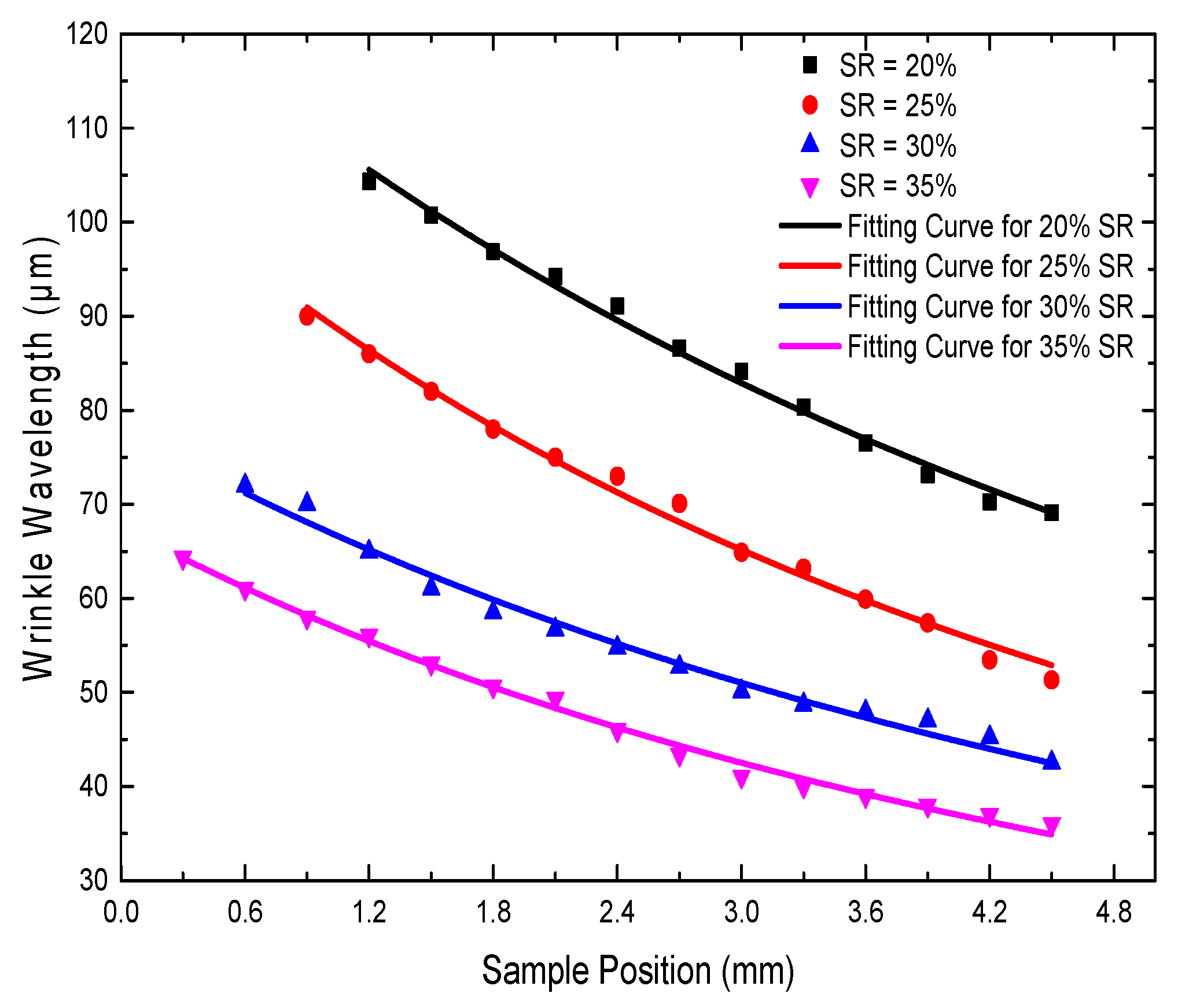
© 2018 by the authors. Licensee MDPI, Basel, Switzerland. This article is an open access article distributed under the terms and conditions of the Creative Commons Attribution (CC BY) license (http://creativecommons.org/licenses/by/4.0/).
Share and Cite
Li, H.; Sheng, B.; Wu, H.; Huang, Y.; Zhang, D.; Zhuang, S. Ring Wrinkle Patterns with Continuously Changing Wavelength Produced Using a Controlled-Gradient Light Field. Materials 2018, 11, 1571. https://doi.org/10.3390/ma11091571
Li H, Sheng B, Wu H, Huang Y, Zhang D, Zhuang S. Ring Wrinkle Patterns with Continuously Changing Wavelength Produced Using a Controlled-Gradient Light Field. Materials. 2018; 11(9):1571. https://doi.org/10.3390/ma11091571
Chicago/Turabian StyleLi, Hongye, Bin Sheng, He Wu, Yuanshen Huang, Dawei Zhang, and Songlin Zhuang. 2018. "Ring Wrinkle Patterns with Continuously Changing Wavelength Produced Using a Controlled-Gradient Light Field" Materials 11, no. 9: 1571. https://doi.org/10.3390/ma11091571
APA StyleLi, H., Sheng, B., Wu, H., Huang, Y., Zhang, D., & Zhuang, S. (2018). Ring Wrinkle Patterns with Continuously Changing Wavelength Produced Using a Controlled-Gradient Light Field. Materials, 11(9), 1571. https://doi.org/10.3390/ma11091571




